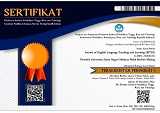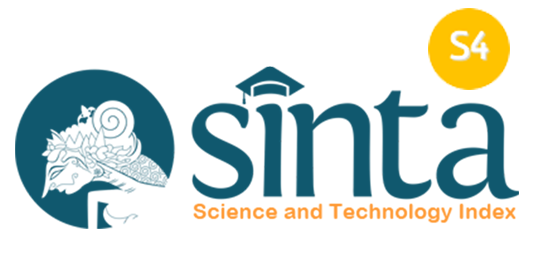An Analysis on the Students’ Ability in Using Personal Pronouns in English
Abstract
English personal pronouns was still problem for students; especially students of Sekolah Tinggi Keguruan dan Ilmu Pendidikan Surya Kasih. Therefore; it was important to conduct a research on students’ ability in using personal pronouns. The purpose of this study was to describe the students’ ability in using subject, object, possessive and reflexive. The participants of the research were 10 students the second semester students who programmed English subject. There were 30 item tests of personal pronouns. The results of the research showed that the students’ average score was 68 and the students’ level of ability on personal pronouns was enough. Based on the kinds of personal pronouns showed the highest score was 72,10 which is on subject pronoun then followed by object pronoun with the score 70,20 then followed by possessive pronoun with the score 67,80 and the lowest score was 64,70 which is on reflexive pronoun. This research claimed that the students found difficulties in using personal pronoun in English due to interference of Indonesian language as their first language.
Keywords
Full Text:
PDFReferences
Azar, B. S. (2002). Understanding and using English grammar (3rd ed). Prentice Hall Regents.
Creswell, J. W. (2014). Research design: Qualitative, quantitative, and mixed methods approaches (4th ed). SAGE Publications.
DeCapua, A. (2010). Grammar for teachers: A guide to American English for native and non-native speakers (Digitally print version). Springer.
Eastwood, J. (2005). Oxford guide to English grammar ([Impr.] 9).
Oxford Univ. Press.
Fitria, T. N. (2019). Errors in students’ writing composition in simple present tense “my daily activity.” EDULANGUE, 2(1), 47–62. https://doi.org/10.20414/edulangue.v2i1.318
Handayani, N. D., & Johan, M. (2018). Problem faced in grammar of EFL students. Khazanah Ilmu Berazam, 1(2 SEPT), 33–41.
Harmer, J. (2006). The practice of English language teaching (3. ed., completely rev. and updated, 8. impr). Longman.
Kamlasi, I. (2019). Describing the students’ grammatical errors on spoken english. ELT-Lectura, 6(1), 83–91. https://doi.org/10.31849/elt-lectura.v6i1.2289
Kamlasi, I., & Nokas, D. N. (2017). Grammatical errors in writing of the second class students of SMA Kristen 1 Soe. Metathesis: Journal of English Language, Literature, and Teaching, 1(1), Article 1. https://doi.org/10.31002/metathesis.v1i1.238
Quirk, R., Greenbaum, S., & Dorling Kindersley Multimedia. (2007). A university grammar of English. Dorling Kindersley.
Royani, S., & Sadiah, S. (2019). An analysis of grammatical errors in students’ writing descriptive text. PROJECT (Professional Journal of English Education), 2(6), 764–770. https://doi.org/10.22460/project.v2i6.p764-770
Siska, S. (2020). Students’ difficulties in using personal pronouns: A case study at the eight grade of SMPN Sakra in the academic year 2018-2019 [Skripsi, Universitas Mataram]. http://eprints.unram.ac.id/16420/
Stobbe, G. (2008). Just enough English grammar illustrated. McGraw-Hill.
Tussifa, F. L., & Natasha, H. (2021). A study on the first grade students’ understanding of personal pronouns in english reading texts at SMPN 1 Singingi. Indonesian Journal of Integrated English Language Teaching, 7(1), 1–11. https://doi.org/10.24014/ijielt.v7i1.13770
DOI: https://doi.org/10.18860/jetle.v3i1.13129
Refbacks
- There are currently no refbacks.
Jalan Gajayana 50 Malang 65144, Jawa Timur, Indonesia

This work is licensed under a Creative Commons Attribution-ShareAlike 4.0 International License.
Indexed by





